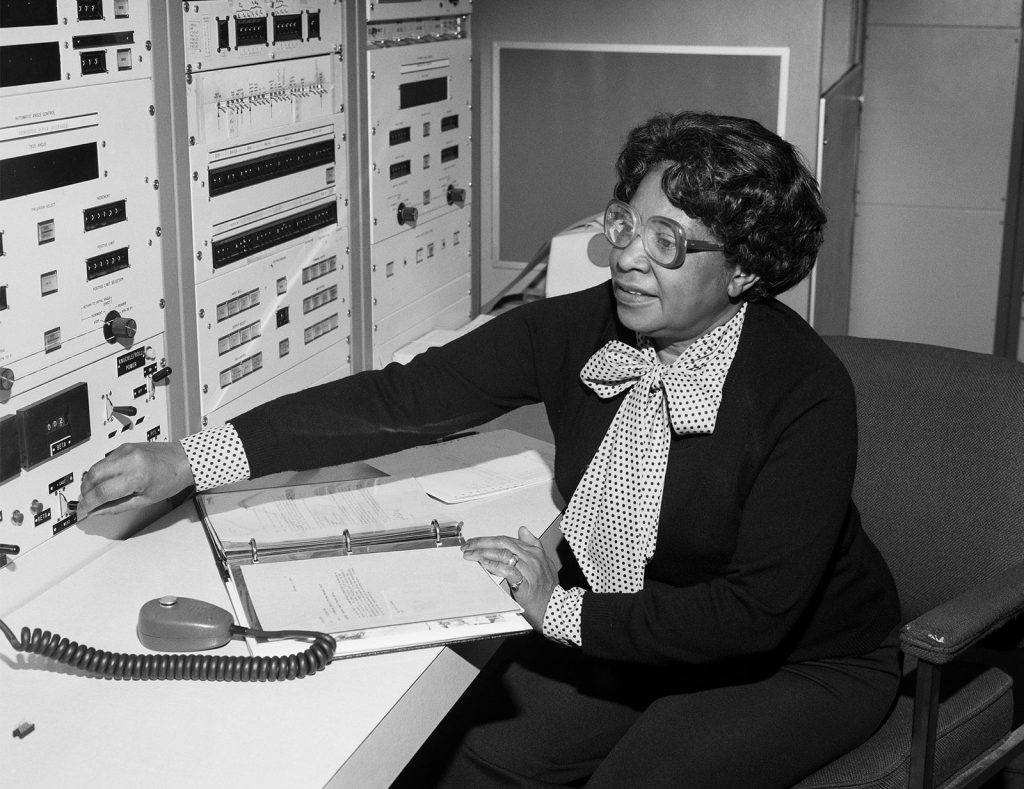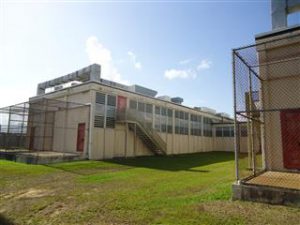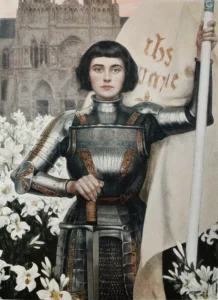“Why don’t you come work for me?” These words snapped Mary W. Jackson out from her heated rant about the insult she had just received by women she thought to be colleagues. She was surprised. She was confused. How did this man she had just met in the hall, a man she had just ranted to, how would he be so willing to just casually offer her a job? She quickly composed herself and accepted. Little did she know that this conversation would put her on track to make NASA history, and ultimately lead to NASA’s D.C. headquarters being named after her!

Mary W. Jackson, a graduate from the Hampton Institute with a degree in math and physical science, had been through various jobs before landing her job as a mathematician at Langley Memorial Aeronautical Laboratory’s segregated West Area Computing section in 1951.1 She had been working under group supervisor Dorthey Vaughn for a little over two years when Vaughn assigned Mary to staff on a project on the Eastside of Langley alongside several other white computers, due to the intense workload and short staff. The work of computing was not foreign to Mary, but what was foreign to her were the Eastside’s winding halls. One pivotal morning, Mary was having a hard time finding a colored bathroom. She could only find the unmarked bathroom door, which she knew was reserved for her white counterparts. Mary resigned to asking a group of white women coming from the unmarked bathroom if they could please direct her to the colored bathroom. The women looked around at each other, and then back at Mary, snickering, before responding with “how would they know where to find her bathroom?” Angry and humiliated, Mary stormed away to find her bathroom. She wasn’t new to the segregation at Langley; it was no different than anywhere else, but this incident stung more than others. The scam of “separate but equal” had never been so apparent to her than in this moment as she walked the halls fuming.2 All Mary thought was how her Langley employee badge gave her access to the same workplace as the white women and compared to them, she had the same, if not more, education, yet she felt her sense of professional equality to the white women quickly torn down by the mundane act of having to use the bathroom. Still fuming later that day as she walked back to the Westside of Langley, she ran into Kazimierz Czarnecki, an assistant section head in the four-by-four-foot Supersonic Pressure Tunnel.3 He greeted her with a simple “Hello, how are you?” and was met with an explosive rant about her humiliation on the Eastside. Being a usually soft-spoken individual, Mary finished her rant and immediately felt embarrassment settle in her chest, knowing she would probably be told something for her outburst. Ready for Czarnecki’s response, she bowed her head. Czarnecki looked at her and asked: “Why don’t you come work for me?”4 A combination of confusion and surprise passed over Mary, but it quickly passed as she eagerly accepted the position

In her time working under Czarnecki, Mary got hands-on experience on conducting experiments, and eventually wanted to do more. Czarnecki encouraged Mary to pursue a training program that would make her eligible for a promotion from mathematician to engineer. Those who entered the program had to take graduate level physics and math courses in an after-work program run by the University of Virginia. Since the courses were held at the segregated Hampton High School, special permission was needed by the City of Hampton for Mary to enroll in the program and sit in the classroom with her white peers.5 During her time in the program, she faced many challenges, such as intimidation and discrimination, and many of her peers didn’t expect her to complete the program. Yet never one to back down from a challenge, Mary endured their stares and comments, and she finished the program.
On top of completing the program, she earned her promotion from mathematician to engineer in 1958. Her promotion would make her the first black female engineer at NASA. That same year, Mary co-authored her first report titled “Effects of Nose Angle and Mach Number on Transition on Cones at Supersonic Speeds.” Her promotion would make her the first black female engineer, which was a huge feat not accomplished before, and it was owed all to her handwork and dedication. For twenty years, Mary enjoyed a successful and productive career authoring and co-authoring almost a dozen research reports.6 Her work was primarily focused on the boundary layer of air around the airplane and its behavior.

Given all the success she had during her career as an engineer, she was hungry to break into the management levels at NASA, which motivated her to work harder. Yet the promotions slowed, and Mary became frustrated with her inability to receive a promotion in management.7 She was often witness to all her white colleagues accepting promotions while she was consistently overlooked, despite her impressive qualifications. This made Mary fall back on her service throughout her life to evaluate what she found important to her. She reflected on the values she taught her Girl Scout Troop: respect, dedication, and hard work.8 She routinely told the girls that if they focused on these values, they could be whatever they wanted in their life. Mary knew she was dedicated to her work. Mary knew she worked hard. Mary knew she respected her supervisors and her colleagues. But the constant overlooking left her feeling somewhat hopeless about her future in NASA. At this time, Mary also reflected on her and her husband’s open-door policy for young Langley recruits who needed a welcoming face when they arrived in D.C. The reason she started her open-door policy is so that young people just starting out had a place to go for advice, a comforting shoulder to lean on or a good meal9
All these thoughts and reflections brought Mary’s frustrations to a head in 1979. She came to realize that perhaps her efforts in breaking the glass ceiling at NASA as an engineer were exhausted. Mary thought that maybe she could make a bigger difference in another area of NASA. It was then that she made the decision to take a demotion into NASA’s Affirmative Action office as Langley’s Federal Women’s Program Manager. Here she felt she was more able to be a voice for young women and people of color who were trying to pursue a career at NASA. And she was a voice. Mary used her time in the Affirmative Action office to address many of the hiring issues within NASA and empower a new generation of scientist, mathematicians, and engineers10 She retired in 1985 from NASA.

Mary W. Jackson passed away in 2005 leaving behind her husband, two children, and an awe-inspiring legacy. Mary was the first female black engineer at NASA, but she was also so much more. Mary was a Girl Scout Troop leader, a mentor for young Langley recruits, a mother, and the administrator in the NASA Affirmative Action office. She worked tirelessly to open opportunities for marginalized group in STEM. Unfortunately, it wasn’t until after her passing that Mary received the recognition that a ground-breaking figure like her should have. In 2019, the Trump Administration signed the Hidden Figures Congressional Gold Medal Act.11 It awarded four female black NASA mathematicians, engineers, and researchers, one of those being Mary W. Jackson. The reception that followed included a keynote speech from deputy director Melanie Sander and Margot Lee Shetterly, the author of the book Hidden Figures. Their speeches retold the story of Mary and her colleagues’ contributions to the Space Race.12 In 2017, NASA Administrator Jim Bridenstine announced the agency’s Washington D.C. headquarters would be named after Mary, saying “Jackson was a part of a group of very important women who helped NASA succeed in getting American astronauts into space.”13 Mary’s impact will forever be felt by those at NASA, as she was one of the first women to break barriers in NASA, and because of her efforts she certainly won’t be the last.
- Sarah Loff, “Mary W. Jackson Biography,” NASA, November 22, 2016, http://www.nasa.gov/content/mary-w-jackson-biography. ↵
- Margot Lee Shetterly, “Hidden Figures: The American Dream and the Untold Story of the Black Women Mathematicians Who Helped Win the Space Race – Margot Lee Shetterly,” Publicism (website), https://publicism.info/biography/hidden/12.html. ↵
- Sarah Loff, “Mary W. Jackson Biography,” NASA, November 22, 2016, http://www.nasa.gov/content/mary-w-jackson-biography. ↵
- Margot Lee Shetterly, “Hidden Figures: The American Dream and the Untold Story of the Black Women Mathematicians Who Helped Win the Space Race – Margot Lee Shetterly,” Publicism (website), https://publicism.info/biography/hidden/12.html. ↵
- “Mary Jackson | Biography & Facts,” Encyclopedia Britannica, https://www.britannica.com/biography/Mary-Jackson-mathematician-and-engineer. ↵
- Sarah Loff, “Mary W. Jackson Biography,” NASA, November 22, 2016, http://www.nasa.gov/content/mary-w-jackson-biography. ↵
- “Mary Jackson | Biography & Facts,” Encyclopedia Britannica, https://www.britannica.com/biography/Mary-Jackson-mathematician-and-engineer. ↵
- “Mary JACKSON,” Scientific Women (website), https://scientificwomen.net/women/jackson-mary-104. ↵
- “Mary JACKSON,” Scientific Women (website), https://scientificwomen.net/women/jackson-mary-104. ↵
- “Mary JACKSON,” Scientific Women (website), https://scientificwomen.net/women/jackson-mary-104. ↵
- Natalie Joseph, “‘Hidden Figures’ Honored at U.S. Capitol for Congressional Gold Medal,” NASA, December 10, 2019, http://www.nasa.gov/feature/hidden-figures-honored-at-us-capitol-for-congressional-gold-medal. ↵
- Natalie Joseph, “‘Hidden Figures’ Honored at U.S. Capitol for Congressional Gold Medal,” NASA, December 10, 2019, http://www.nasa.gov/feature/hidden-figures-honored-at-us-capitol-for-congressional-gold-medal. ↵
- Sean Potter, “NASA Names Headquarters After ‘Hidden Figure’ Mary W. Jackson,” NASA, June 24, 2020, http://www.nasa.gov/press-release/nasa-names-headquarters-after-hidden-figure-mary-w-jackson. ↵



19 comments
Maggie Trujillo
This was a great article about Mary Jackson. I love the movie Hidden Figures, but this article was able to focus on Mary Jackson and her accomplishments. Despite many odds against her, Mary continued to persevere and leave a legacy behind. I was surprised to read and learn that Mary left her job as an engineer to become NASA’s Affirmative Action office as Langley’s Federal Women’s Program Manager. It would have been interesting to see what Mary could have done if she was given her promotions and rose up in management.
Vincent Villanueva
Hi Soleil! I would like to thank you for this insightful article. Mary W. Jackson’s story is so wholesome and inspirational in a determination sense, becoming the first female African American engineer for NASA. She not only did that but also helped others around her. I especially loved the film Hidden Figures which was inspired by this which was pretty cool to me. It is a shame she did not get to enjoy everything she accomplished and the legacy she left behind. All in all, great article.
Idaly Oropeza
I have always loved watching the Hidden Figures movie. It is truly inspiring and motivational to see Mary J. Jacksons story unfold. Jackson is such a great role model to not only women and young girls but more importantly black women. To this day there are instances where people are being judged by the color of their skin or their gender. For women to hear about a strong and independent African American woman that helped create a historical moment is completely amazing. Reading this article taught me more about Mary J. Jacksons story and was super fun to read.
Abigail Delarosa
Every time I hear the story of Mary Jackson it never fails to inspire me. She is such a motivational woman for all women. I’ve seen the movie “Hidden Figure” many times and just like your article it never get old. I love the way you told her story and flow your story had. The details you incorporated about her life I can tell you did some good research. The passion you had writing this story it really showed great work with your article.
Abigail Delarosa
I loved watching the movie “Hidden Figures” it was such a great movie and gave hope for women of all color that they can indeed follow their dream no matter how crazy it might be. You did an amazing job telling Mary Jackson’s story and eveytime I learn about her life and her journey it amazes me everytime. I enjoyed learning more her that they left out in the movie so great job.
Serenity Kamenski
Hate to be the cliche, but the film Hidden Figures was very inspirational to say the least. With that out of the way, your article was well-done. It had great pacing, was detailed-oriented, and did an amazing job capturing Mary Jackson’s character and convictions. Her story shows how through hard-work and an unweaving will to prove to oneself and others, can lead to various accomplishments that are well earned. In addition, Jackson was faced with many hardships, but always pushed forward. Thank you for the read.
Alex Trevino
Definitely a fun read. As someone who only knew Mary by watching the Hidden Figures movie, this was a really fun read getting to know more about her story, what she accomplished after her career, and what her career brought for others, even after her death. Mary Jacks0n is someone I consider an inspiration to anyone who feels they can’t do something simply because of the environment surrounding them, and all someone needs is to try, and they can succeed all on their own.
Grace Malacara
Mary Jackson’s story is such an inspiring one. You did a great job telling her story, the article was very engaging and well written. She accomplished many feats and it’s evident how important her work was and is. And how she truly persevered through the challenges that faced her during those times. Her story was a great topic and I really enjoyed reading this article.
Aidan Farrell
This was a very well done and fun to read article, Soleil. It was interesting to dive deep into one of the women that helped exponentially with NASA in the earl 1960s, and someone who inspired the hit film Hidden Figures. This women is staple of American STEM research, and you really did a good job telling her story with grace. You had great word choice, and the images you used really helped to drive the story along. Overall, amazing job.
Eliana Villarreal
This was such an inspirational article about Mary Jackson. I am not one to be very strong in either math or science but I greatly admire those who are more inclined of those topics and especially if they are a woman. It was unfortunate that she was discriminated against in her own place of work but her efforts to speak her mind opened many more doors for her. I had no idea she was highly admired by NASA but I am glad she was able to get that recognition she so well deserved and I am sure her legacy will live on for decades to come.